Electric Vehicles: Pipe Dream or Product of the Future Case Analysis
VerifiedAdded on 2022/08/12
|7
|1249
|24
Case Study
AI Summary
This case study analyzes the paper "Electric Vehicles: Pipe Dream or Product of the Future" by Clayton (1999), examining the challenges and opportunities in the electric vehicle market. The analysis addresses key questions, including obstacles to mainstream adoption (refueling and cost), advantages (eco-friendliness, cost savings) and disadvantages (charging limitations), and the Ford Ranger's suitability for electric technology. It also explores the strategies of Tesla, government investments in EVs, and the concept of energy independence. The document provides insights into the evolution of electric vehicles, including cost analysis, and the impact of technological advancements on the automotive industry. The analysis also includes insights into the current market position of Ford Ranger and Tesla and the government's role in promoting electric vehicle technology.

MANAGEMENT OF TECHNOLOGY 0
Case Analysis
Case Analysis
Paraphrase This Document
Need a fresh take? Get an instant paraphrase of this document with our AI Paraphraser
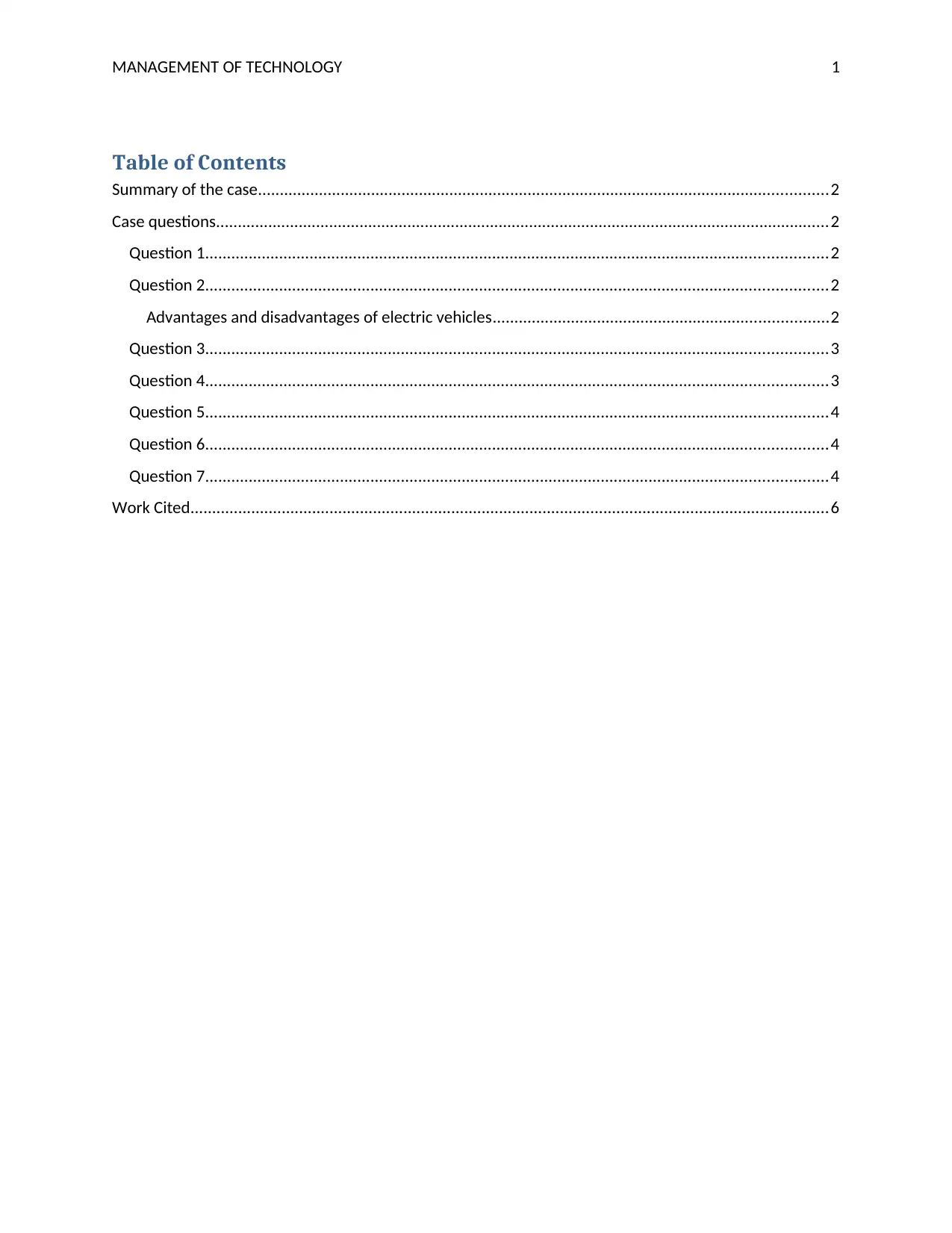
MANAGEMENT OF TECHNOLOGY 1
Table of Contents
Summary of the case...................................................................................................................................2
Case questions.............................................................................................................................................2
Question 1...............................................................................................................................................2
Question 2...............................................................................................................................................2
Advantages and disadvantages of electric vehicles.............................................................................2
Question 3...............................................................................................................................................3
Question 4...............................................................................................................................................3
Question 5...............................................................................................................................................4
Question 6...............................................................................................................................................4
Question 7...............................................................................................................................................4
Work Cited...................................................................................................................................................6
Table of Contents
Summary of the case...................................................................................................................................2
Case questions.............................................................................................................................................2
Question 1...............................................................................................................................................2
Question 2...............................................................................................................................................2
Advantages and disadvantages of electric vehicles.............................................................................2
Question 3...............................................................................................................................................3
Question 4...............................................................................................................................................3
Question 5...............................................................................................................................................4
Question 6...............................................................................................................................................4
Question 7...............................................................................................................................................4
Work Cited...................................................................................................................................................6
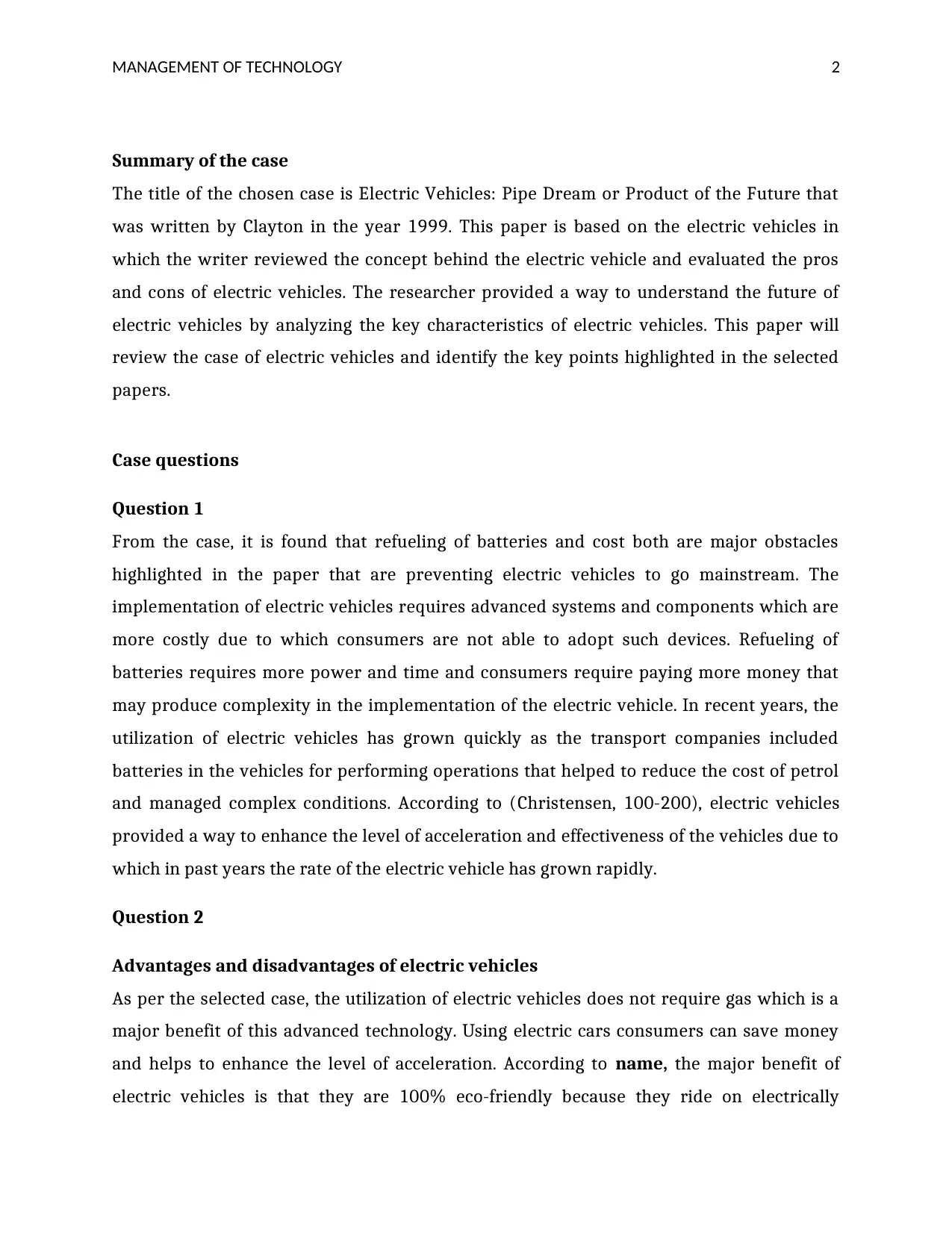
MANAGEMENT OF TECHNOLOGY 2
Summary of the case
The title of the chosen case is Electric Vehicles: Pipe Dream or Product of the Future that
was written by Clayton in the year 1999. This paper is based on the electric vehicles in
which the writer reviewed the concept behind the electric vehicle and evaluated the pros
and cons of electric vehicles. The researcher provided a way to understand the future of
electric vehicles by analyzing the key characteristics of electric vehicles. This paper will
review the case of electric vehicles and identify the key points highlighted in the selected
papers.
Case questions
Question 1
From the case, it is found that refueling of batteries and cost both are major obstacles
highlighted in the paper that are preventing electric vehicles to go mainstream. The
implementation of electric vehicles requires advanced systems and components which are
more costly due to which consumers are not able to adopt such devices. Refueling of
batteries requires more power and time and consumers require paying more money that
may produce complexity in the implementation of the electric vehicle. In recent years, the
utilization of electric vehicles has grown quickly as the transport companies included
batteries in the vehicles for performing operations that helped to reduce the cost of petrol
and managed complex conditions. According to (Christensen, 100-200), electric vehicles
provided a way to enhance the level of acceleration and effectiveness of the vehicles due to
which in past years the rate of the electric vehicle has grown rapidly.
Question 2
Advantages and disadvantages of electric vehicles
As per the selected case, the utilization of electric vehicles does not require gas which is a
major benefit of this advanced technology. Using electric cars consumers can save money
and helps to enhance the level of acceleration. According to name, the major benefit of
electric vehicles is that they are 100% eco-friendly because they ride on electrically
Summary of the case
The title of the chosen case is Electric Vehicles: Pipe Dream or Product of the Future that
was written by Clayton in the year 1999. This paper is based on the electric vehicles in
which the writer reviewed the concept behind the electric vehicle and evaluated the pros
and cons of electric vehicles. The researcher provided a way to understand the future of
electric vehicles by analyzing the key characteristics of electric vehicles. This paper will
review the case of electric vehicles and identify the key points highlighted in the selected
papers.
Case questions
Question 1
From the case, it is found that refueling of batteries and cost both are major obstacles
highlighted in the paper that are preventing electric vehicles to go mainstream. The
implementation of electric vehicles requires advanced systems and components which are
more costly due to which consumers are not able to adopt such devices. Refueling of
batteries requires more power and time and consumers require paying more money that
may produce complexity in the implementation of the electric vehicle. In recent years, the
utilization of electric vehicles has grown quickly as the transport companies included
batteries in the vehicles for performing operations that helped to reduce the cost of petrol
and managed complex conditions. According to (Christensen, 100-200), electric vehicles
provided a way to enhance the level of acceleration and effectiveness of the vehicles due to
which in past years the rate of the electric vehicle has grown rapidly.
Question 2
Advantages and disadvantages of electric vehicles
As per the selected case, the utilization of electric vehicles does not require gas which is a
major benefit of this advanced technology. Using electric cars consumers can save money
and helps to enhance the level of acceleration. According to name, the major benefit of
electric vehicles is that they are 100% eco-friendly because they ride on electrically
⊘ This is a preview!⊘
Do you want full access?
Subscribe today to unlock all pages.

Trusted by 1+ million students worldwide
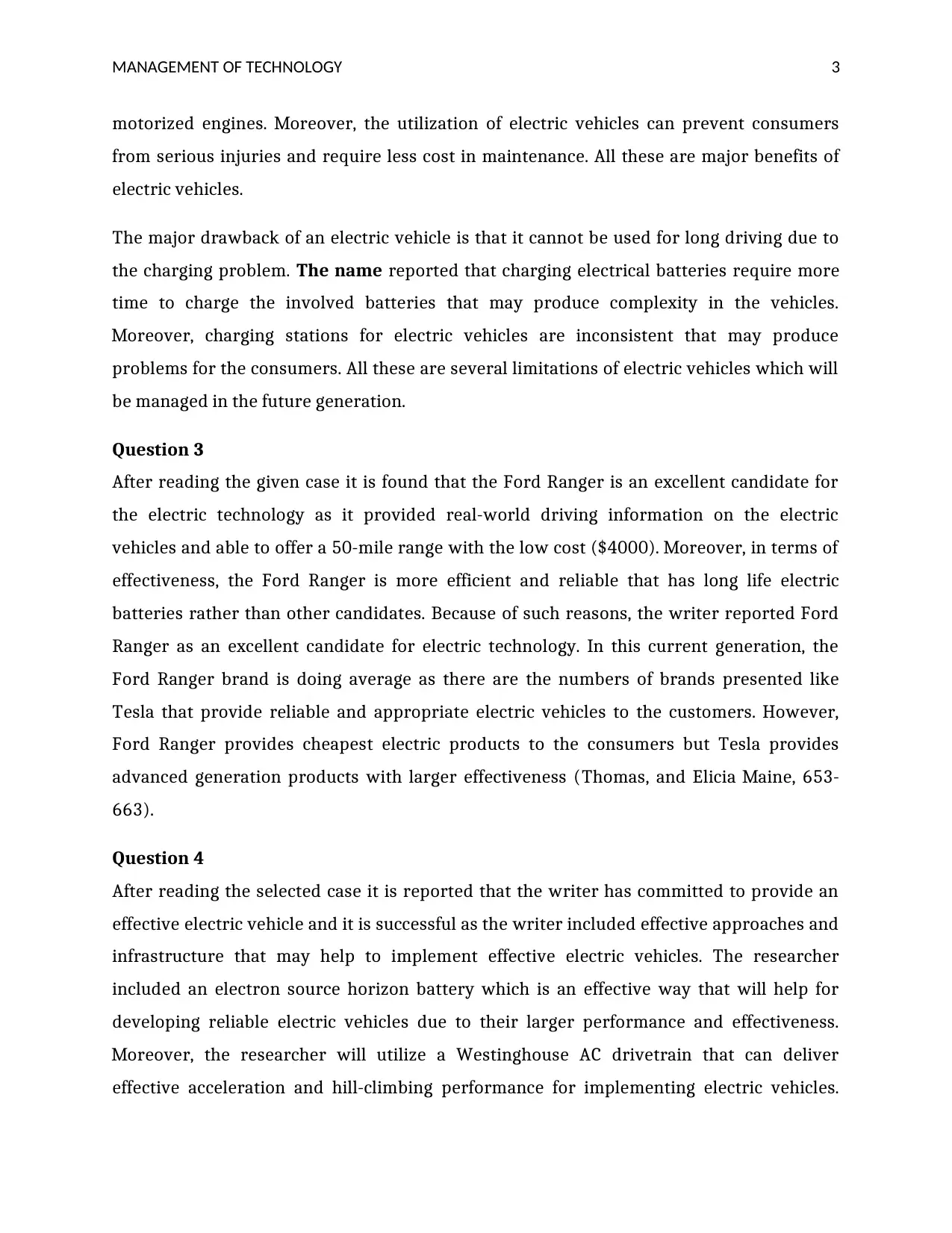
MANAGEMENT OF TECHNOLOGY 3
motorized engines. Moreover, the utilization of electric vehicles can prevent consumers
from serious injuries and require less cost in maintenance. All these are major benefits of
electric vehicles.
The major drawback of an electric vehicle is that it cannot be used for long driving due to
the charging problem. The name reported that charging electrical batteries require more
time to charge the involved batteries that may produce complexity in the vehicles.
Moreover, charging stations for electric vehicles are inconsistent that may produce
problems for the consumers. All these are several limitations of electric vehicles which will
be managed in the future generation.
Question 3
After reading the given case it is found that the Ford Ranger is an excellent candidate for
the electric technology as it provided real-world driving information on the electric
vehicles and able to offer a 50-mile range with the low cost ($4000). Moreover, in terms of
effectiveness, the Ford Ranger is more efficient and reliable that has long life electric
batteries rather than other candidates. Because of such reasons, the writer reported Ford
Ranger as an excellent candidate for electric technology. In this current generation, the
Ford Ranger brand is doing average as there are the numbers of brands presented like
Tesla that provide reliable and appropriate electric vehicles to the customers. However,
Ford Ranger provides cheapest electric products to the consumers but Tesla provides
advanced generation products with larger effectiveness (Thomas, and Elicia Maine, 653-
663).
Question 4
After reading the selected case it is reported that the writer has committed to provide an
effective electric vehicle and it is successful as the writer included effective approaches and
infrastructure that may help to implement effective electric vehicles. The researcher
included an electron source horizon battery which is an effective way that will help for
developing reliable electric vehicles due to their larger performance and effectiveness.
Moreover, the researcher will utilize a Westinghouse AC drivetrain that can deliver
effective acceleration and hill-climbing performance for implementing electric vehicles.
motorized engines. Moreover, the utilization of electric vehicles can prevent consumers
from serious injuries and require less cost in maintenance. All these are major benefits of
electric vehicles.
The major drawback of an electric vehicle is that it cannot be used for long driving due to
the charging problem. The name reported that charging electrical batteries require more
time to charge the involved batteries that may produce complexity in the vehicles.
Moreover, charging stations for electric vehicles are inconsistent that may produce
problems for the consumers. All these are several limitations of electric vehicles which will
be managed in the future generation.
Question 3
After reading the given case it is found that the Ford Ranger is an excellent candidate for
the electric technology as it provided real-world driving information on the electric
vehicles and able to offer a 50-mile range with the low cost ($4000). Moreover, in terms of
effectiveness, the Ford Ranger is more efficient and reliable that has long life electric
batteries rather than other candidates. Because of such reasons, the writer reported Ford
Ranger as an excellent candidate for electric technology. In this current generation, the
Ford Ranger brand is doing average as there are the numbers of brands presented like
Tesla that provide reliable and appropriate electric vehicles to the customers. However,
Ford Ranger provides cheapest electric products to the consumers but Tesla provides
advanced generation products with larger effectiveness (Thomas, and Elicia Maine, 653-
663).
Question 4
After reading the selected case it is reported that the writer has committed to provide an
effective electric vehicle and it is successful as the writer included effective approaches and
infrastructure that may help to implement effective electric vehicles. The researcher
included an electron source horizon battery which is an effective way that will help for
developing reliable electric vehicles due to their larger performance and effectiveness.
Moreover, the researcher will utilize a Westinghouse AC drivetrain that can deliver
effective acceleration and hill-climbing performance for implementing electric vehicles.
Paraphrase This Document
Need a fresh take? Get an instant paraphrase of this document with our AI Paraphraser
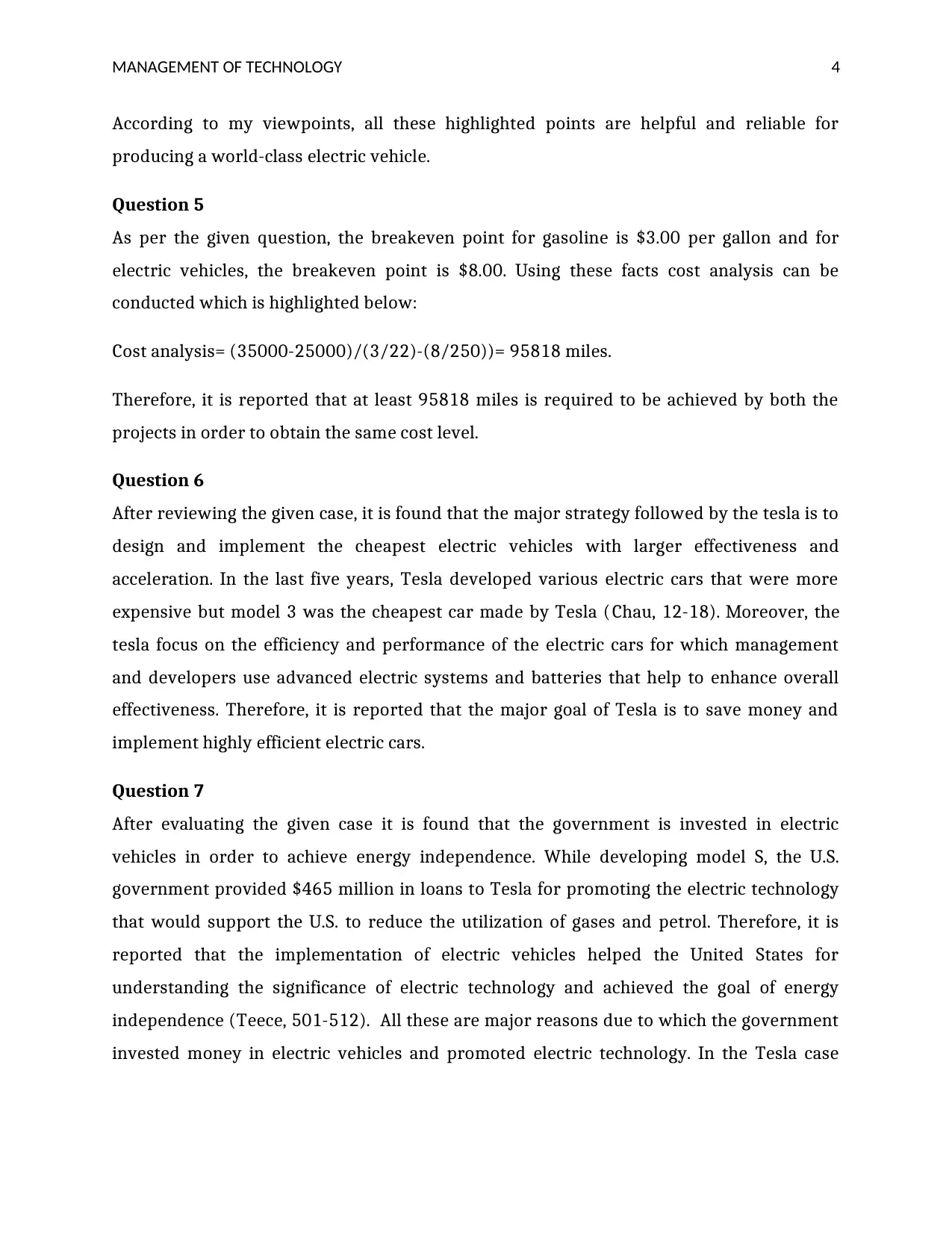
MANAGEMENT OF TECHNOLOGY 4
According to my viewpoints, all these highlighted points are helpful and reliable for
producing a world-class electric vehicle.
Question 5
As per the given question, the breakeven point for gasoline is $3.00 per gallon and for
electric vehicles, the breakeven point is $8.00. Using these facts cost analysis can be
conducted which is highlighted below:
Cost analysis= (35000-25000)/(3/22)-(8/250))= 95818 miles.
Therefore, it is reported that at least 95818 miles is required to be achieved by both the
projects in order to obtain the same cost level.
Question 6
After reviewing the given case, it is found that the major strategy followed by the tesla is to
design and implement the cheapest electric vehicles with larger effectiveness and
acceleration. In the last five years, Tesla developed various electric cars that were more
expensive but model 3 was the cheapest car made by Tesla (Chau, 12-18). Moreover, the
tesla focus on the efficiency and performance of the electric cars for which management
and developers use advanced electric systems and batteries that help to enhance overall
effectiveness. Therefore, it is reported that the major goal of Tesla is to save money and
implement highly efficient electric cars.
Question 7
After evaluating the given case it is found that the government is invested in electric
vehicles in order to achieve energy independence. While developing model S, the U.S.
government provided $465 million in loans to Tesla for promoting the electric technology
that would support the U.S. to reduce the utilization of gases and petrol. Therefore, it is
reported that the implementation of electric vehicles helped the United States for
understanding the significance of electric technology and achieved the goal of energy
independence (Teece, 501-512). All these are major reasons due to which the government
invested money in electric vehicles and promoted electric technology. In the Tesla case
According to my viewpoints, all these highlighted points are helpful and reliable for
producing a world-class electric vehicle.
Question 5
As per the given question, the breakeven point for gasoline is $3.00 per gallon and for
electric vehicles, the breakeven point is $8.00. Using these facts cost analysis can be
conducted which is highlighted below:
Cost analysis= (35000-25000)/(3/22)-(8/250))= 95818 miles.
Therefore, it is reported that at least 95818 miles is required to be achieved by both the
projects in order to obtain the same cost level.
Question 6
After reviewing the given case, it is found that the major strategy followed by the tesla is to
design and implement the cheapest electric vehicles with larger effectiveness and
acceleration. In the last five years, Tesla developed various electric cars that were more
expensive but model 3 was the cheapest car made by Tesla (Chau, 12-18). Moreover, the
tesla focus on the efficiency and performance of the electric cars for which management
and developers use advanced electric systems and batteries that help to enhance overall
effectiveness. Therefore, it is reported that the major goal of Tesla is to save money and
implement highly efficient electric cars.
Question 7
After evaluating the given case it is found that the government is invested in electric
vehicles in order to achieve energy independence. While developing model S, the U.S.
government provided $465 million in loans to Tesla for promoting the electric technology
that would support the U.S. to reduce the utilization of gases and petrol. Therefore, it is
reported that the implementation of electric vehicles helped the United States for
understanding the significance of electric technology and achieved the goal of energy
independence (Teece, 501-512). All these are major reasons due to which the government
invested money in electric vehicles and promoted electric technology. In the Tesla case

MANAGEMENT OF TECHNOLOGY 5
study, the writer provided complete information about Tesla and highlighted the key
reasons for investing money in the field of electric vehicles.
study, the writer provided complete information about Tesla and highlighted the key
reasons for investing money in the field of electric vehicles.
⊘ This is a preview!⊘
Do you want full access?
Subscribe today to unlock all pages.

Trusted by 1+ million students worldwide
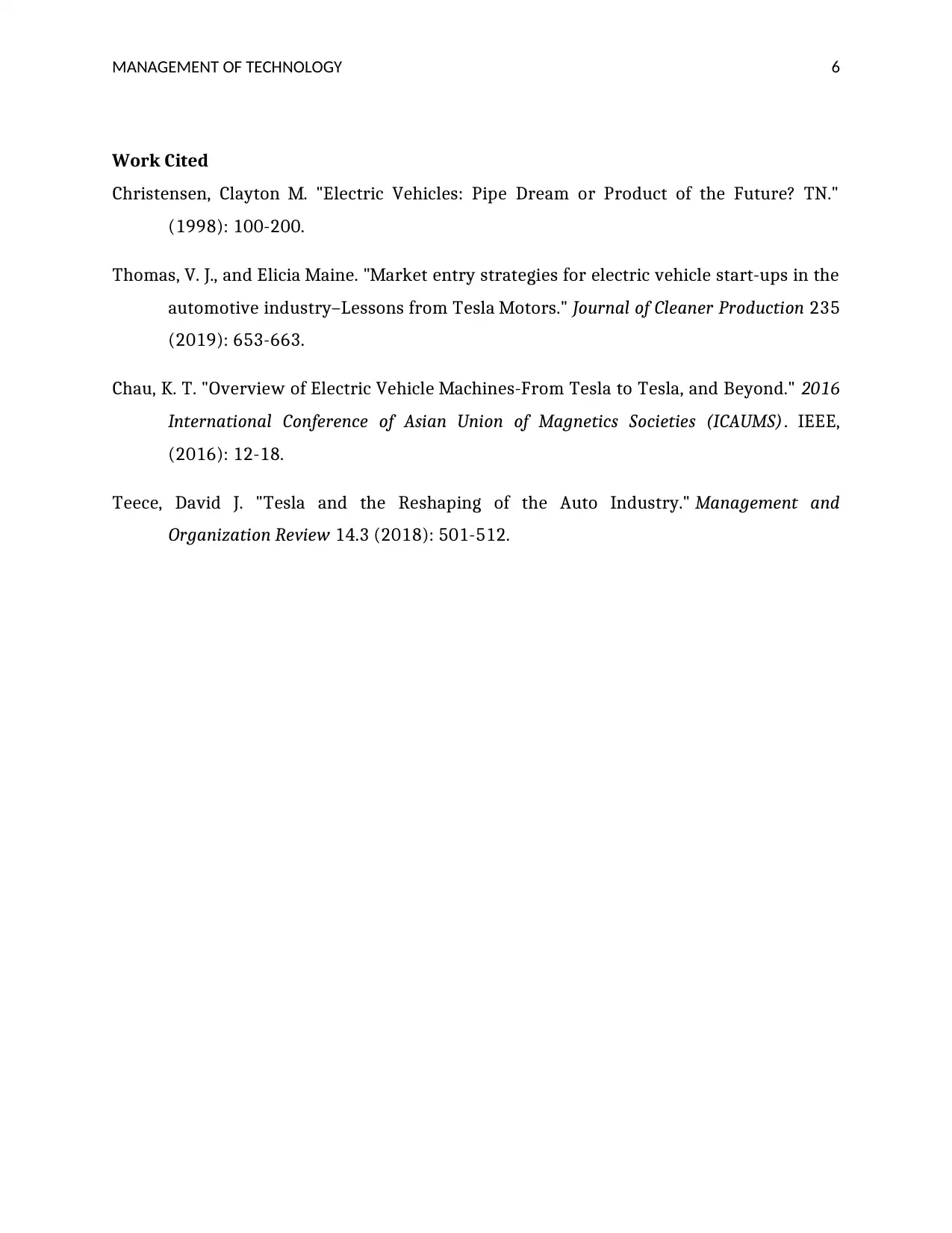
MANAGEMENT OF TECHNOLOGY 6
Work Cited
Christensen, Clayton M. "Electric Vehicles: Pipe Dream or Product of the Future? TN."
(1998): 100-200.
Thomas, V. J., and Elicia Maine. "Market entry strategies for electric vehicle start-ups in the
automotive industry–Lessons from Tesla Motors." Journal of Cleaner Production 235
(2019): 653-663.
Chau, K. T. "Overview of Electric Vehicle Machines-From Tesla to Tesla, and Beyond." 2016
International Conference of Asian Union of Magnetics Societies (ICAUMS). IEEE,
(2016): 12-18.
Teece, David J. "Tesla and the Reshaping of the Auto Industry." Management and
Organization Review 14.3 (2018): 501-512.
Work Cited
Christensen, Clayton M. "Electric Vehicles: Pipe Dream or Product of the Future? TN."
(1998): 100-200.
Thomas, V. J., and Elicia Maine. "Market entry strategies for electric vehicle start-ups in the
automotive industry–Lessons from Tesla Motors." Journal of Cleaner Production 235
(2019): 653-663.
Chau, K. T. "Overview of Electric Vehicle Machines-From Tesla to Tesla, and Beyond." 2016
International Conference of Asian Union of Magnetics Societies (ICAUMS). IEEE,
(2016): 12-18.
Teece, David J. "Tesla and the Reshaping of the Auto Industry." Management and
Organization Review 14.3 (2018): 501-512.
1 out of 7
Related Documents
Your All-in-One AI-Powered Toolkit for Academic Success.
+13062052269
info@desklib.com
Available 24*7 on WhatsApp / Email
![[object Object]](/_next/static/media/star-bottom.7253800d.svg)
Unlock your academic potential
Copyright © 2020–2025 A2Z Services. All Rights Reserved. Developed and managed by ZUCOL.





